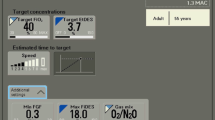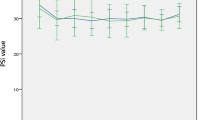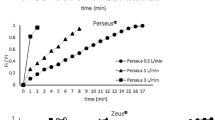Abstract
The FLOW-i anesthesia machine (Maquet, Solna, Sweden) can be equipped with automated gas control (AGC), an automated low flow tool with target control of the inspired oxygen concentration (FIO2) and end-expired concentration (FA) of a potent inhaled anesthetic. We examined the performance and quantitative aspects of the AGC. After IRB approval and individual informed consent, anesthesia in 24 ASA I–II patients undergoing abdominal or gynecological surgery was maintained with sevoflurane in O2/air with a target FIO2 of 40 % and a target sevoflurane FA (FAsevo) of 2.0 %. The AGC tool also allows the user to select 1 out of 9 different speeds with which the target FAsevo can be reached (with 9 being the fastest speed). Eight patients each were randomly assigned to speed 2, 4, and 6 (= group 2, group 4, and group 6, respectively); these three speeds were chosen arbitrarily. AGC was activated immediately after securing the airway, which defined the start of the study, and the study ended 60 min later. The following parameters were compared among the three groups: age, height, weight, FIO2, FAsevo, BIS values, heart rate, mean arterial blood pressure, fresh gas flow, and sevoflurane usage. Agent usage as reported by the FLOW-i was compared among the three groups. Patient demographics and maintenance FGF did not differ among groups. A very short-lived very high FGF (≈20 L min−1 for 8–12 s) ensured that the target FIO2 was attained within 1–2 min in all patients. FAsevo was 1.8 % after 15, 10, and 6 min, and 1.9 % after 30, 20 and 15 min in groups 2, 4, and 6, respectively. Blood pressure, heart rate, and BIS values did not differ among the three groups. BIS values remained acceptable in all patients, even with the slowest speed. Cumulative agent usage differed among all three groups between 2 and 30 min (lower with the lower speed), and between group 2 and 6 between 35 and 60 min. AGC combines an exponentially decreasing FGF pattern with a choice of ramp functions for the end-expired target concentration of the inhaled anesthetic. Consequently, both FGF and the choice of speed become factors that influence agent usage. After 15 min, a 300 mL min−1 maintenance FGF reduces agent usage to near closed-circuit conditions. This new addition to our automated low flow armamentarium helps to reduce anesthetic waste, cost, and pollution, while minimizing the ergonomic burden of low flow anesthesia.
Similar content being viewed by others
Avoid common mistakes on your manuscript.
1 Background
While the use of low fresh gas flows (FGFs) with a circle breathing system decreases anesthetic waste and thus costs and pollution, most anesthesia providers intuitively use a 1.5–2 L min−1 FGF [1]. The routine use of FGF well below 1 L min−1 is avoided for a variety of reasons. First, rebreathing will cause the concentration inhaled by the patient to differ from that dialed by the anesthesia provider, which may be perceived as lack of control: the dialed concentration of O2, N2, N2O and/or the inhaled agent will no longer match what the anesthesia provider has selected [2]. Second, more frequent vaporizer and rotameter adjustments are needed, and these can be tedious or distracting, especially during the busy induction phase. Third, vaporizer dial setting variability increases, making it more difficult to predict the vaporizer setting required for the individual patient. Automated target control allows the user to directly target the end-expired partial pressure (FA) of the anesthetic agent. This will eliminate the above mentioned disadvantages associated with the use of low FGFs, and it will help reduce the incidence of under-dosing: in a large prospective study designed to maintain MAC above 0.7 MAC, anesthesia providers failed to do so in more than 15 % of the time when they were controlling FGF and vaporizer settings themselves [3]. Automated target control helps the clinician to use low flows more consistently [4, 5].
Even more important, directly targeting the inspired oxygen concentration (FIO2) will make low flow safer by preventing inspired hypoxic mixture formation [6, 7]. During conventional, non-automated low flow with O2/N2O or O2/air mixtures, inspired hypoxic mixtures can form during despite the presence of a hypoxic guard system [6, 7].
The Zeus (Dräger, Lübeck, Germany) and the Aisys (GE, Madison, WI) offer target controlled automated closed circuit and minimal flow anesthesia, respectively. Recently, the FLOW-i® (Maquet, Solna, Sweden) has also been equipped with a target controlled automated low flow anesthesia feature, called AGC® (automated gas control). The aim of this study was to examine the clinical performance of the first released AGC software version (4.0.0).
2 Materials and methods
After obtaining IRB approval and informed consent from all individual participants (OLV study number 2013/058, Belgian Registration number B126201317885), 24 ASA I–II patients were enrolled. Patients were undergoing abdominal or gynecological surgery that was expected to last at least 1 h. Premedication consisted of oral alprazolam (0.5 mg) 1 h prior to surgery. In addition to routine monitors, BIS monitoring (Covidien, Dublin, Ireland) was used to help assess the impact of the rate of rise of the end-expired sevoflurane concentration on the hypnotic component of anesthesia (see below).
With the machine still in standby mode, the agent (sevoflurane) and the AGC parameters were “preselected” (= entered before activating any carrier gas flow) (Fig. 1): carrier gas = O2/air; FGF = 300 mL min−1 (= maintenance FGF, with the current default and lowest possible FGF being 300 mL min−1); and target FIO2 = 40 %, target FA sevoflurane (FAsevo) = 2.0 %. The AGC tool also allows the user to select 1 out of 9 different speeds with which the target FAsevo can be reached (1 = slowest, 9 = fastest). Out of a choice of 9 different speeds, we arbitrarily decided to study the effects of using speeds 2, 4, or 6. Using Excel’s random function, eight patients were randomly assigned to speed 2, 4 or 6 (= group 2, group 4, and group 6, respectively). After closing the AGC pop-up screen, the “start case” knob was activated, causing the FLOW-i to deliver 6 L min−1 of 80 % O2 in air, facilitating preoxygenation of the patient. After anesthesia had been induced with intravenous sufentanil (0.1–0.15 μg/kg) and propofol (2–3 mg/kg), the trachea was intubated, facilitated with rocuronium (0.6 mg/kg).
AGC (automated gas control) settings. The AGC tool allows the user to select the target inspired O2 concentration (target FIO2) and target end-expired agent concentration (target EtSEV) as well as the rate of rise (speed) of the end-expired sevoflurane concentration towards target EtSEV. The speed pertains only to the rate of rise of the end-expired agent concentration, NOT to the FIO2 (which always takes priority). Speed ranges from 1 to 8 up to “max”, the latter being the fastest rate of rise. In the “additional settings” tab, and from left to right, the lowest acceptable maintenance fresh gas flow, the maximum inspired agent concentration, and carrier gas composition can be selected. At the time of writing, 0.3 L min−1 is the default fresh gas setting as well as the lowest maintenance fresh gas flow that can be selected
After securing the airway (confirmed by the presence of end-expired CO2), mechanical ventilation was activated by twisting a knob that simultaneously activated AGC. This defined the start of the study. Additional sufentanil and rocuronium were administered as deemed necessary by the attending anesthesiologist. Controlled mechanical ventilation was adjusted to maintain normocapnia. Data collection ended 60 min after activating the AGC mode.
Besides patient demographic data (age, height, weight and gender), the following data were collected every minute: FIO2, FAsevo, BIS values, heart rate, (noninvasive) mean arterial blood pressure, FGF, and sevoflurane usage reported by the FLOW-i. The amount of sevoflurane usage reported by the cumulative agent display of the FLOW-i was previously found to closely reflect the amount that had disappeared from the injector as measured by weighing the injector before and after use [8]. ANOVA followed by the Holm–Sidak test was used to compare all data among the three groups, with p < 0.05 denoting statistical significance.
3 Results
Patient demographics did not differ among groups (Table 1). The FGFs were the same in all three groups (Fig. 2). A very short-lived very high FGF (≈20 L min−1) for 8–12 s (Fig. 2) ensured the target FIO2 was attained within 1–2 min in all groups (Fig. 3). After 2 min, the FIO2, presented as average (SD), were 40 (1), 40 (1), and 41 (1) % with speed 2, 4, and 6, respectively. FAsevo was 1.8 % after 15, 10, and 6 min and 1.9 % after 30, 20 and 15 min in groups 2, 4, and 6, respectively (Fig. 4). Blood pressure and heart rate did not differ among groups (Fig. 5a, b). BIS values did not differ among the three groups, and remained acceptable in all patients: the highest BIS value (63) was found in a patient from the slowest speed (group 2), and lasted only 1 min (Fig. 6a, b, c).
Cumulative agents usage differed among all three groups between 2 and 30 min (lower with the lower speed), and between groups 2 and 6 between 35 and 60 min (Table 1; Fig. 7). The use of speed 2 instead of speed 6 reduces cumulative agent usage by 45 % (from 4 to 2.2 mL) after 10 min, and by 35 % (from 4.9 to 3.2 mL) after 15 min (Table 1). Cumulative agent usage during the last 45 min (when FGF was reduced to 300 mL min−1) did not differ among the three groups (Fig. 7).
Cumulative sevoflurane usage (mL liquid sevoflurane). Cumulative sevoflurane usage differed between all groups up until 30 min, and between speeds 2 and 6 up for the entire length of the study. Results are presented as average and standard deviation. Thin line speed 2; thick grey line speed 4; thick black line speed 6. Bars represents standard deviations
4 Discussion
The AGC feature of the FLOW-i allows the user to select a target FIO2 as well as a target FA and the ramp speed of the inhaled agent. The speed feature does not apply to FIO2: the target FIO2 is attained within 1–2 min by the use of a very short lived (about 10 s) very high FGF (≈20 L min−1).
Next, the FGF is exponentially reduced from 20 to 0.3 L min−1 over the course of 15 min. The rate of rise and predicted time to target of the anesthetic agent can be followed on the monitor screen, and is continually updated during wash-in (Fig. 8). The fresh gas controller acts, at present and by design, the same irrespective of the selected speed. But despite FGF being the same in all groups, agent usage is lower when a slower speed is used: the use of speed 2 instead of speed 6 reduces cumulative agent usage by 45 % (from 4 to 2.2 mL) after 10 min, and by 35 % (from 4.9 to 3.2 mL) after 15 min. These differences are due solely to the difference in injection rate of liquid agent.
After 15 min, FGF is decreased to the default (and currently lowest) maintenance FGF of 0.3 L min−1 (it is possible to select a higher default maintenance FGF if desired so). As a result, cumulative agent usage during the last 45 min of the study period did not differ among the three groups. Therefore, any differences in cumulative agent usage at 60 min were caused by differences in agent delivery during the first 15 min. These findings corroborate our earlier findings that the manner in which anesthetic agent target concentration is reached during initial wash-in has a pronounced effect on cumulative agent usage at the end of a procedure [9]. The 0.3 L min−1 maintenance FGF is 100–120 mL min−1 above O2 uptake by the adult patient [10]. Reducing FGF by another 100 mL min−1 would have reduced sevoflurane agent usage by 0.66 mL liquid sevoflurane per hour (calculated assuming the waste gas would contain 2 % sevoflurane). It has to be noted that under the conditions of this study, no target FIO2 changes were made, which would have prompted the AGC to temporarily increase FGF again.
The automated low flow system decreases the FGF exponentially and rapidly over 15 min to attain the maintenance 300 mL min−1 FGF. Because it is the combination of FGF control and the ability to control the rate of rise and thus the injection rate that determines the system’s behavior, “automated gas control” seems indeed the proper name to describe the target control algorithms.
How fast should the FA of the anesthetic agent rise after intravenous agents have been administered to induce anesthesia [11]? Several factors need to be taken into account. First, the residual and waning effects of the intravenous induction agents (propofol, opioids) need to be taken in consideration, as well as the drug interactions between all these drugs [12, 13]. Second, the rate of rise has to be titrated not only towards the physiological reserve of the patient but also towards the anticipated time of incision. In the absence of a noxious stimulus, how slow can the FA of the anesthetic agent be allowed to rise without risking awareness? The BIS data suggest that the hypnotic component of anesthesia remained adequate even with the lowest speed, but these results need to be confirmed in a larger patient population. On the other hand, if the agent concentration rises too fast, hypotension may ensue. Being able to (pre)select and adjust the rate of rise may help optimize anesthetic depth during the interval between securing the airway and surgical incision, but requires further clinical validation.
By reducing the number of interventions the anesthesia provider has to make, automated low flow machines make low flow more ergonomic [5]. Because the AGC allows the user to preselect anesthetic agent targets before inducing anesthesia, and because the same knob activates both the desired ventilation mode and AGC, a single twist of one knob may reduce the number of adjustments during the busy induction period to just one.
To summarize, the FLOW-i’s AGC rapidly achieves the desired FIO2, and it combines an exponentially decreasing FGF pattern with a choice of ramp functions for the end-expired target concentration of the inhaled anesthetic during wash-in. The choice of ramp function has an effect on overall cumulative agent usage. The default 300 mL min−1 FGF reduces agent usage to near closed-circuit conditions during maintenance.
References
Body SC, Fanikos J, De Peiro D, Philip JH, Segal BS. Individualized feedback of volatile agent use reduces fresh gas flow rate, but fails to favorably affect agent choice. Anesthesiology. 1999;90:1171–5.
Lowe HJ, Ernst EA. The quantitative practice of anesthesia: use of closed circuit. Baltimore/London: Williams & Wilkins; 1981.
Avidan MS, Jacobsohn E, Glick D, Burnside BA, Zhang L, Villafranca A, Karl L, Kamal S, Torres B, O’Connor M, Evers AS, Gradwohl S, Lin N, Palanca BJ, Mashour GA, BAG-RECALL Research Group. Prevention of intraoperative awareness in a high-risk surgical population. N Engl J Med. 2011;365:591–600.
Kennedy RR, French RA. A ten-year audit of fresh gas flows in a New Zealand hospital: the influence of the introduction of automated agent delivery and comparisons with other hospitals. Anaesth Intensive Care. 2014;42:65–72.
Singaravelu S, Barclay P. Automated control of end-tidal inhalation anaesthetic concentration using the GE Aisys Carestation™. Br J Anaesth. 2013;110:561–6.
De Cooman S, Schollaert C, Hendrickx J, Peyton PJ, Van Zundert T, De Wolf AM. Hypoxic guard systems do not prevent rapid hypoxic inspired mixture formation. J Clin Mon Comp. (2014). Epub ahead of print 2014 Oct 1.
Hendrickx JFA, De Wolf AM, De Hert S. O2-anybody? [Editorial]. Eur J Anesth. 2015;32:371–3.
Dehouwer A, De Ridder S, Carette R, De Cooman S, De Wolf AM, Hendrickx JFA. How accurate is agent usage reported by automated low flow anesthesia machines? Accepted for presentation at the ESA annual meeting, May 31, 2015, Berlin, Germany [abstract, code 1AP19-9; abstract number 326].
De Cooman S, De Mey N, Dewulf BB, Carette R, Deloof T, Sosnowski M, De Wolf AM, Hendrickx JF. Desflurane consumption during automated closed-circuit delivery is higher than when a conventional anesthesia machine is used with a simple vaporizer–O2–N2O fresh gas flow sequence. BMC Anesthesiol. 2008;8:4.
Robinson GJ, Peyton PJ, Terry D, Malekzadeh S, Thompson B. Continuous measurement of gas uptake and elimination in anesthetized patients using an extractable marker gas. J Appl Physiol. 2004;97:960–6.
Heyse B, Proost JH, Hannivoort LN, Eleveld DJ, Luginbühl M, Struys MM, Vereecke HE. A response surface model approach for continuous measures of hypnotic and analgesic effect during sevoflurane–remifentanil interaction: quantifying the pharmacodynamic shift evoked by stimulation. Anesthesiology. 2014;120:1390–9.
Vereecke HE, Proost JH, Heyse B, Eleveld DJ, Katoh T, Luginbühl M, Struys MM. Interaction between nitrous oxide, sevoflurane, and opioids: a response surface approach. Anesthesiology. 2013;118:894–902.
Acknowledgments
The study has not been externally funded. The FLOW-i has been provided under a temporary loan contract. Jan Hendrickx has received lecture support, travel reimbursements, equipment loans, consulting fees and/or meeting organizational support from a number of companies involved with inhaled agent delivery (alphabetically): AbbVie, Acertys, Air Liquide, Allied healthcare, Armstrong Medical, Baxter, Draeger, GE, Hospithera, Heinen und Lowensein, Intersurgical, Maquet, MDMS, MEDEC, Micropore, Molecular, NWS, Philips, Quantum Medical.
Conflict of interest
The authors declare that they have no conflict of interest.
Ethical standard
The study has been approved by the IRB of the OLV hospital, Aalst, Belgium, part of OLV study number 2013/058, Belgian Registration number B126201317885.
Author information
Authors and Affiliations
Corresponding author
Rights and permissions
About this article
Cite this article
Carette, R., De Wolf, A.M. & Hendrickx, J.F.A. Automated gas control with the Maquet FLOW-i. J Clin Monit Comput 30, 341–346 (2016). https://doi.org/10.1007/s10877-015-9723-6
Received:
Accepted:
Published:
Issue Date:
DOI: https://doi.org/10.1007/s10877-015-9723-6












